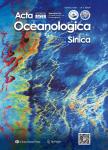Spreading-rate dependence of hydroacoustic and teleseismic seismicity of ridge-transform systems:East Pacific Rise,Galapagos Ridge,and Mid-Atlantic Ridge
Spreading-rate dependence of hydroacoustic and teleseismic seismicity of ridge-transform systems:East Pacific Rise,Galapagos Ridge, and Mid-Atlantic Ridge作者机构:Key Laboratory of Ocean and Marginal Sea GeologySouth China Sea Institute of OceanologyInnovation Academy of South China Sea Ecology and Environmental EngineeringChinese Academy of SciencesGuangzhou510301China Southern Marine Science and Engineering Guangdong Laboratory(Guangzhou)Guangzhou511458China China-Pakistan Joint Research Center on Earth SciencesChinese Academy of Science-Higher Education Commission(Pakistan)Islamabad45320Pakistan Department of Ocean Science and EngineeringSouthern University of Science and TechnologyShenzhen518055China Department of Geology and GeophysicsWoods Hole Oceanographic InstitutionFalmouthWoods HoleMA02543USA
出 版 物:《Acta Oceanologica Sinica》 (海洋学报(英文版))
年 卷 期:2022年第41卷第5期
页 面:124-135页
核心收录:
学科分类:07[理学] 0707[理学-海洋科学] 0708[理学-地球物理学]
基 金:The Fund of the Southern Marine Science and Engineering Guangdong Laboratory(Guangzhou)under contract No.GML2019ZD0205 the National Natural Science Foundation of China under contract Nos 42006055,41704049,41890813,41976066,and 41976064 The Fund of the State Key Laboratory of Marine Geology,Tongji University under contract No.MGK202011 the Scholarship of China Scholarship Council the Program of Chinese Academy of Sciences under contract Nos Y4SL021001,QYZDYSSW-DQC005,131551KYSB20200021,133244KYSB20180029,and ISEE2021PY03 the International Conference Communication Fund for Graduate Students,Tongji University.
主 题:East Pacific Rise Galapagos Ridge Mid-Atlantic Ridge hydroacoustic and teleseismic seismicity ridge-transform system
摘 要:Seismicity in ocean ridge-transform systems reveals fundamental processes of mid-ocean ridges,while comparisons of seismicity in different oceans remain rare due to a lack of detection of small events.From 1996 to 2003,the Pacific Marine Environmental Laboratory of the National Oceanic and Atmospheric Administration(NOAA/PMEL)deployed several hydrophones in the eastern Pacific Ocean and the northern Atlantic Ocean.These hydrophones recorded earthquakes with small magnitudes,providing us with opportunities to study the seismic characteristics of ridge-transform systems at different spreading rates and make further comparisons of their differences.This study comparatively analyzed hydroacoustic and teleseismic data recorded on the fast-spreading East Pacific Rise(EPR,10°S to 12°N),intermediate-spreading Galapagos Ridge(103°W to 80°W),and slow-spreading Mid-Atlantic Ridge(MAR,15°N to 37°N).We present a systematic study of the spatial and temporal distribution of events,aftershock seismicity,and possible triggering mechanisms of aftershock sequences.Our analysis yields the following conclusions.(1)From the hydroacoustic data,the EPR transform faults had the highest average seismicity rate among the three regions.(2)Along-ridge event distributions show that a high number of earthquakes were concentrated on the EPR,while they became dispersed on the GR and fewer and more scattered on the MAR,reflecting that the different tectonic origins were closely correlated with the spreading rate.(3)Analysis from mainshock-aftershock sequences shows no significant differences in the aftershock decay rate among the three regions.(4)Multiple types of aftershock triggering models were inferred from Coulomb stress changes:strike-slip mainshocks triggered strike-slip aftershocks and normal faulting aftershocks,and normal faulting mainshocks triggered normal faulting aftershocks.Although these results are case studies,they may be applicable to other ocean ridge-transform systems in future investigations.Our results provide important new insights into the seismicity of global ocean ridge-transform systems.



